Top 7 UNESCO World Heritage Sites in Crete
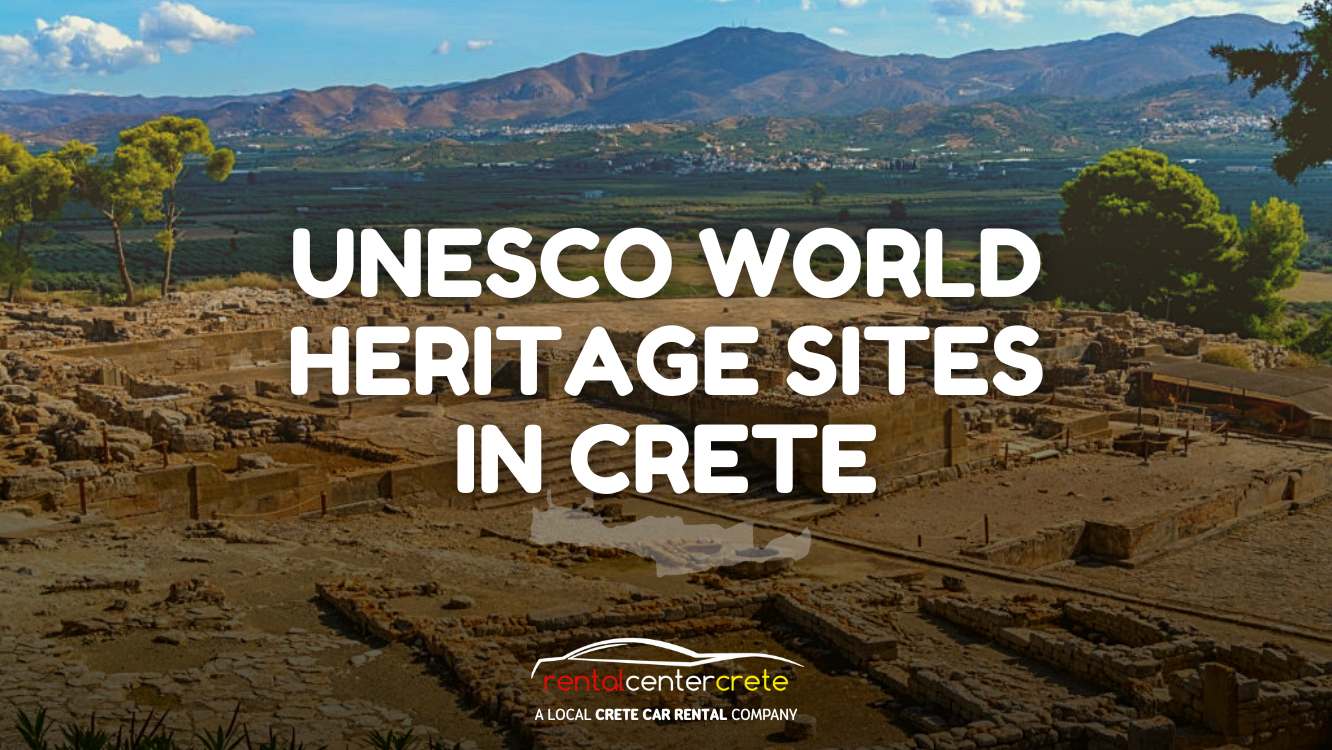
Crete, the largest island in Greece, is home to four UNESCO World Heritage Sites that showcase the island’s rich history and cultural heritage. Palace of Knossos, Palace of Phaistos, Palace of Malia, Palace of Kydonia, and Palace of Zakros are all Bronze Age Minoan palace complexes that offer a fascinating glimpse into the lives and cultures of the ancient Minoan civilization. These palaces feature stunning architectural design, intricate frescoes, and other artefacts that attest to the advanced nature of the Minoans. The gorge of Samaria, and the Spinalonga Fortress are included in the list of sites in Crete that are full of history. The UNESCO World Heritage Sites in Crete provide visitors with a unique opportunity to explore one of the world’s earliest civilizations and to appreciate the contributions that such a remarkable culture made to human history. These top Unesco sites in Crete are witnesses to the impressive Minoan civilizations that left a tremendous impact on the life and culture of Crete.
Listed below are the Top 7 UNESCO World Heritage Sites in Crete.
- Knossos Palace: The archaeological site of Knossos, which is situated in Crete, is considered to be the oldest city in Europe. It dates back to the Bronze Age.
- Palace of Phaistos: The complex spans an area of around 8,000 square metres and comprises a collection of structures, which include a central courtyard in addition to residential quarters, storage areas, and workshops.
- Palace of Malia: It was built during the Middle Minoan period and is considered to be one of the greatest and most important palaces that the Minoan civilisation ever produced (1900-1700 BCE).
- Palace of Zakros: The Palace of Zakros likely served as the Minoan gateway to the east, as evidenced by a number of Middle Eastern artefacts discovered on the site.
- Kydonia Palace: Discovered by Greek, Danish, and Swedish archaeologists, the Minoan palace of Kydonia is found in what is now the city of Chania in northwest Crete.
- Gorge of Samaria National Park: The Samaria gorge stretches for 16 kilometres between the Omalos plateau and the Libyan Sea, making it one of the longest in Europe.
- Fortress of Spinalonga: The deserted island off the coast of Crete has become a major draw for visitors in recent years. Spinalonga is well-known for its narrow pebble beaches and shallow waves, in addition to its citadel and abandoned leper colony.
1. Knossos Palace
The Knossos Palace is an important archaeological monument located on the Greek island of Crete, not far from the modern city of Heraklion. Knossos Palace is among the most significant and famous of Greece’s archaeological sites. Crete was home to one of Europe’s earliest and most advanced civilizations, the Minoans, who built this palace somewhere between 3000 and 1450 B.C. The palace was first occupied shortly following its construction in the year 2000 B.C. and remained so until its destruction in the year 1375 B.C. British archaeologist Arthur Evans conducted the excavations in the early 20th century and recreated most of the site based on his findings. The Throne Room, the Grand Staircase, and the Central Court are just a few of the stunning features that tourists may see in the remains of the Knossos Palace. There are many beautiful frescoes and other ornamental elements at the site that shed light on the artistic and cultural practices of the Minoans.
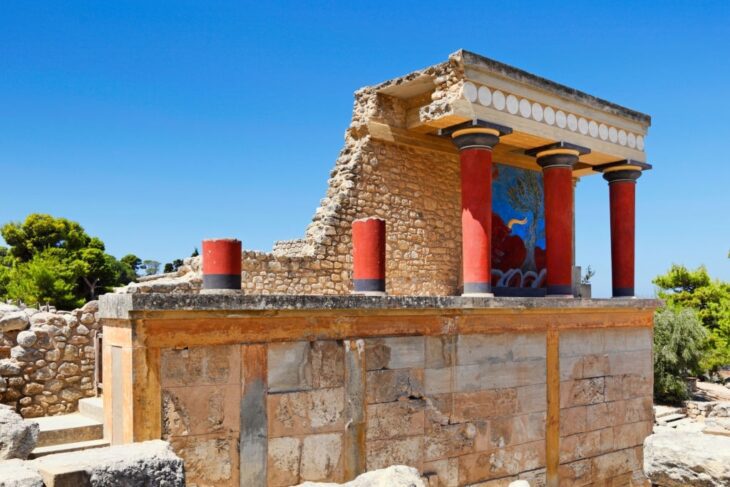
The history of Knossos Palace begins in the Neolithic period, around 7000 BC, when the area was first inhabited by a small community of farmers and herders. Over time, the community grew and developed into a larger and more complex society, which eventually gave rise to the Minoan civilization. The palace itself was built around 1900 BC, during the height of the Minoan civilization. It was originally a smaller structure, but over time it was expanded and renovated by successive rulers, eventually becoming a sprawling complex of buildings covering an area of around 20,000 square metres. The palace was a centre of political, economic, and religious power, and served as the residence of the ruling monarchs. It was a hub of cultural activity, with artisans, musicians, and other creative professionals living and working within the palace complex. The palace was destroyed around 1375 BC, possibly as a result of an earthquake or an invasion by foreign forces. While the site was abandoned after its destruction, it continued to be an important site of pilgrimage and veneration for many centuries, and was eventually rediscovered and excavated in the early 20th century by British archaeologist Arthur Evans.
The spot is a stunning example of the ingenuity and artistry of humankind. It is a tribute to the extraordinary architectural and creative achievements of Minoan culture, which was one of the earliest and most accomplished civilizations in Europe. The Knossos Palace is a testament to these achievements. The site provides a testament that is either singular or extraordinary to a cultural tradition or to a civilisation that is no longer in existence but once existed in the area. The Knossos Palace is among the most notable and well-preserved archaeological buildings from the Minoan civilisation, which was an important contributor to the growth of Western civilization. The Minoans lived on the island of Crete.
The Knossos Palace in Crete is a must-see attraction for anyone interested in history, archaeology, or ancient civilizations. The palace was the center of the Minoan civilization and features many impressive structures and artefacts. The top must-see attractions include the Throne Room, with its central throne and elaborate frescoes; the Grand Staircase, a sweeping staircase decorated with frescoes depicting animals; the Central Court, a large open-air courtyard with a central altar and other structures; the Lustral Basin, a circular pool used for religious rituals; and the North Entrance, which is decorated with frescoes depicting the bull-leaping ceremony. Visitors have the option to take guided tours, explore educational exhibits, and participate in interactive experiences to learn more about the history and culture of the Minoan civilization. Generally, the Knossos Palace is an unforgettable destination that offers a unique glimpse into the daily life and culture of one of the world’s earliest civilizations.
2. Palace of Phaistos
The Palace of Phaistos is an archaeological site located on the southern coast of Crete, Greece. It was once a center of political, economic, and cultural power in ancient Minoan civilization and is considered one of the most important archaeological sites in the Aegean region. The palace was built around 1900 BC, during the height of Minoan civilization, and was destroyed by fire around 1450 BC. It was then rebuilt and destroyed again around 1200 BC. The site covers an area of about 8,000 square metres and consists of a complex of buildings, including a central courtyard, storerooms, workshops, and living quarters. The palace is notable for its unique architectural features, including a large central staircase and an intricate system of drainage and plumbing. Visitors to the Palace of Phaistos are able to explore the ruins of the palace complex and see the remains of the various structures that once made up the site. They get to see the impressive frescoes and other decorative elements that have survived from the Minoan period. Some of the most notable features of the site include the Propylon (a monumental entranceway), the Central Court, and the Royal Chambers. The Palace of Phaistos offers visitors a unique glimpse into the daily life, culture, and achievements of the Minoan civilization. It is a must-see destination for anyone interested in ancient history, archaeology, or cultural heritage.
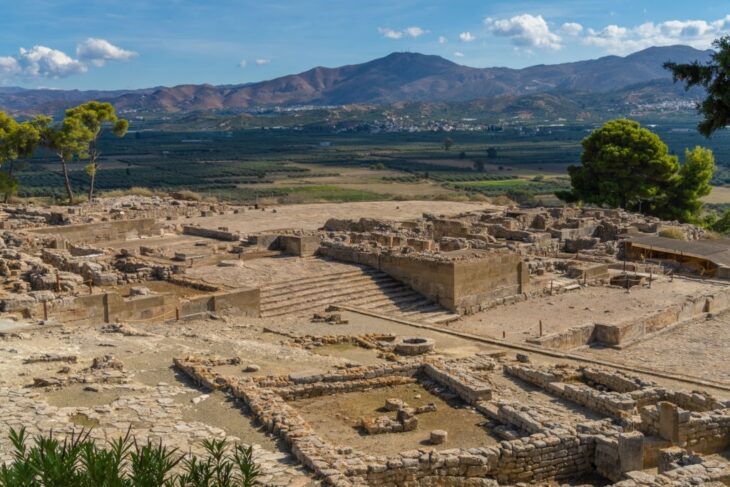
The Palace of Phaistos, along with the archaeological site of the Minoan palace of Knossos, was included on the tentative list of the UNESCO World Heritage Sites list, and its date of submission was January 16, 2014. These locations were chosen for their exceptional significance to human history and culture, as well as their contribution to our knowledge of the progression of human civilization, and they were deemed worthy of UNESCO World Heritage Site status as a result. The site is an extraordinary example of a type of building, architectural or technological ensemble, or landscape that highlights major periods in human history. The Palace of Phaistos is an essential example of a palace complex from the Bronze Age, and it is a prime example of the advanced architectural and engineering techniques used by the Minoans.
The Palace of Phaistos is an impressive archaeological site that offers visitors a unique glimpse into the ancient Minoan civilization. Some of the top must-see attractions at the site include
The Central Court, a large open-air courtyard in the centre of the palace complex. It is surrounded by columns and features a central altar and other structures. A monumental entranceway to the palace, decorated with impressive frescoes and other decorative elements called the Propylon is a sight to behold.
There are the Royal Chambers, the living quarters of the palace’s ruling monarchs, and feature impressive frescoes and other decorative elements. Another must-see part of the palace is the Corridor of the Procession Fresco. It is a long, narrow corridor decorated with an impressive fresco depicting a procession of people and animals. The Archive Room is another interesting part worth exploring. It is a small room where a large number of clay tablets were discovered, providing important insights into the administrative and economic systems of the Minoan civilization.
Some of the best activities to enjoy at the Palace of Phaistos include educational exhibits. There are a number of educational exhibits and displays throughout the site that provide additional context and information about the palace and its significance. Another perfect activity to do at the site is photography. The Palace of Phaistos is a beautiful and photogenic site, and visitors are encouraged to take photos of the impressive ruins and decorative elements. The site is surrounded by beautiful natural scenery and offers plenty of opportunities for relaxation and contemplation, making it a great place to unwind and soak up the atmosphere. Visitors get to enjoy guided tours of the site, which provide valuable insights into the history, architecture, and culture of the palace and the Minoan civilization.
3. Palace of Malia
The Palace of Malia is an archaeological site on the northern coast of Crete, Greece. It was built around 1900 BC and destroyed by an earthquake around 1700 BC. The site is about 7,500 square metres in size and is made up of a group of buildings with a central courtyard, storage rooms, workshops, and living quarters. The palace has a vast central staircase, an impressive drainage system, and a network of underground tunnels that make it stand out. Visitors to the Palace of Malia get to explore the ruins of the palace complex and see the remains of the various structures that once made up the site. They are able to see the beautiful frescoes and other decorations from the Minoan period that have been kept. The Propylon, which is a huge entranceway, the Central Court, and the Palace’s drainage system are some of the most interesting parts of the site. The palace was built around 1900 BC during the height of the Minoan civilization and served as a centre of political, economic, and cultural power.
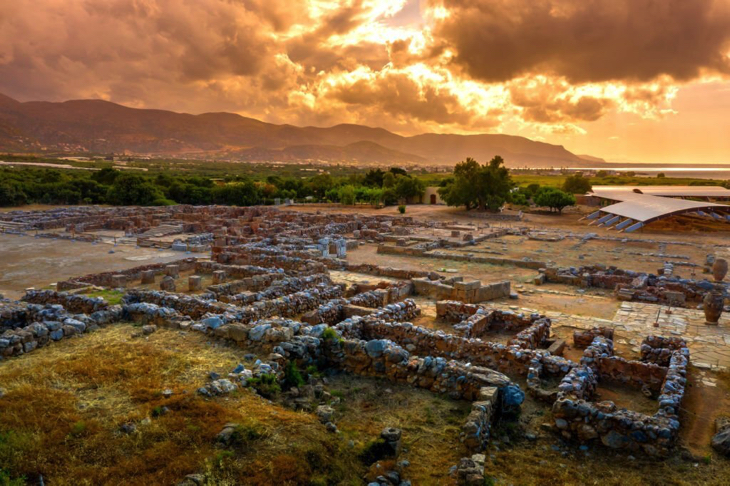
One of the greatest and most important palaces of the Minoan civilization, it was constructed during the Middle Minoan period (1900-1700 BCE). A magnificent palace was built (6000-2900 BCE) on a spot that had been inhabited since the Neolithic era. The original palace was constructed some time about 1900 BCE, but an earthquake in 1700 BCE caused it to collapse. Shortly after, a new palace was constructed on the same site, and it is the said structure that has survived to the present day.
The Palace of Malia served as a governmental and cultural hub for the Minoans on the island of Crete. In addition to living quarters, storage, and workshops, the palace housed sacred spaces. There were fortifications all around the palace, and a wide moat served as an additional barrier. The Palace of Malia is a stunning architectural feat and a witness to the Minoans’ sophisticated culture and creative prowess. Beautiful frescoes depicting scenes from everyday life, religious ceremonies, and mythology adorned the walls of the palace.
The Palace of Malia was included in the UNESCO World Heritage Sites tentative list in January of 2014. It is an exceptional illustration of a type of building, architectural or technological ensemble, or landscape that depicts crucial stages in the progression of human history, and the site is located in the United States. The Palace of Malia is a significant example of a palace complex from the Bronze Age, and it is a prominent example of the excellent architectural and engineering techniques utilised by the Minoans. The palace was built on the island of Malia.
Some of the top must-see attractions in the Palace of Malia include the Central court. The Central Court is the heart of the palace and a must-see attraction. It is surrounded by various rooms and features a large circular hearth in the middle. The North Entrance is a monumental entrance to the palace and is one of the most impressive features of the site. It is decorated with stunning frescoes and provides a glimpse into the Minoan civilization’s sophisticated architectural skills. Another must see in the palace are the royal quarters. The Royal Quarters are a set of rooms located on the western side of the palace that are believed to have been used by the royal family. They are decorated with beautiful frescoes and offer a fascinating glimpse into the luxurious lifestyle of the Minoans.
The Hypostyle Crypt is a room located in the palace’s basement, which features an impressive array of columns. It is believed to have been used for religious ceremonies and is one of the most unique features of the palace. The South Propylon is a monumental entrance on the southern side of the palace. It is decorated with beautiful frescoes and is one of the most well-preserved features of the site. The east and west magazines are two interesting parts of the palace to explore. They were a set of rooms used for storing various goods.
The best activity to try when visiting the palace is taking a guided tour. A guided tour is the best way to explore the palace and learn about its history and significance. Guided tours are available in several languages and are led by knowledgeable and experienced guides who are able to answer all the questions. Others opt to explore the palace on their own. There are plenty of informational signs and maps available that help visitors navigate the site. Visitors are able to take their time exploring the various rooms and features of the palace and learn about the Minoan civilization at their own pace.
Another worthwhile thing to do is attend a cultural event at the palace of Malia. The Palace of Malia hosts various cultural events throughout the year, including music concerts, theatre performances, and dance shows. Check the schedule of events to see if there are any upcoming performances during the visit. Enjoying the scenic view while at the Palace of Malia is a relaxing activity that requires no physical effort. The Palace of Malia is located on a hill overlooking the sea, and it offers breathtaking views of the surrounding landscape. Take some time to appreciate the scenic beauty of the site and take plenty of photos to capture the moment. There are several restaurants and cafes located near the Palace of Malia that offer delicious local cuisine. Sample some traditional Cretan dishes, such as grilled lamb, moussaka, and dakos, and enjoy a taste of the local culture.
4. Palace of Zakros
The most remote of the Minoan palaces is Zakros Palace, situated south of Palaikastro on Crete’s eastern coast. The extremely violent north winds that traverse Cape Sidero on Crete’s northeastern tip are unable to reach there due to its location. It is the smallest of the four major palaces, which include Knossos, Malia, and Phaistos, and was revealed last. Prior to abandoning the excavation, D.G. Howarth of the British School of Archaeology in Athens unearthed twelve previously unknown houses in the town surrounding the Palace. Nikolaos Platon restarted excavations and uncovered a palace that had not been robbed at the time of its destruction in 1961. The digging has continued right up until the present day. More contemporary and scientific excavation techniques must be used due to the lateness of the finding, making its site one of the most significant for Minoan archaeology since World War II.
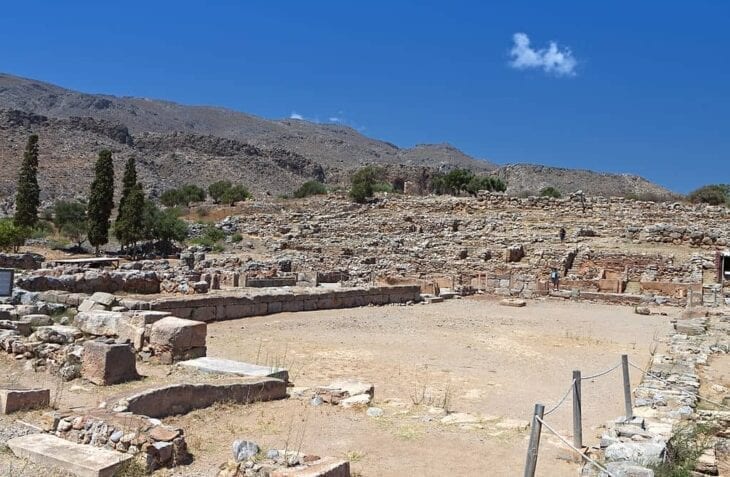
The Palace of Zakros likely served as the Minoan gateway to the east, as evidenced by a number of Middle Eastern artefacts discovered on the site. At the West Wing, an elephant tusk and six oxhide ingots were recovered, and beside the well, Canaanite jars were uncovered.
Like the other palaces, Zakros was reconstructed following the destruction of the previous palaces by an earthquake. The second palace was constructed circa 1600 BCE and demolished around 1450 BCE, along with other sites of Minoan civilization on Crete. Probably due to the suddenness of the devastation, a great number of artefacts were left in place. The palace comprised 8,000 square metres, 150 chambers, and a Central Court of around 30 by 12 metres, which was substantially smaller than Knossos’.
The UNESCO World Heritage Committee tentatively included the Palace of Zakros (well known as the Palace of Kato Zakros) on their list of “Minoan Palatial Centers,” in 2014. Located in present-day eastern Crete, the Palace of Zakros was the centre of Minoan civilization during the Late Minoan period (1600-1100 BC). It is a palace complex that has been exceptionally well-preserved, and it is filled with architectural elements and artefacts that give information on the political, economic, and social life of the Minoan civilization.
Some of the top must-see attractions at the Palace of Zakros are in the central courtyard. It was the heart of the palace and is surrounded by various rooms and buildings. Visitors get to explore the courtyard and see the remains of the ancient architecture and frescoes. Another interesting attraction is the throne room, where the ruler of the palace held court and received important guests. The palace was home to many people, including the ruler, priests, and servants. Visitors get to explore the residential quarters and see the remains of the living spaces, kitchens, and workshops.
People who visit the palace get to see the storage rooms, where it was a major trade hub before. The storage rooms were used to store goods such as olive oil, wine, and grain. Visitors are able to see the remains of the storage jars and learn about the trade networks of the Minoan civilization. Visitors of all ages, especially children, get to appreciate the archaeological museum at the palace of Zakros. Located near the palace complex, the museum displays artefacts from the palace and the surrounding area. Visitors are able to see pottery, jewellery, and other objects that provide insights into the daily life and culture of the Minoan civilization.
The Zakros Palace offers its visitors numerous activities and experiences to enjoy. Some of the best activities to do at the Palace of Zakros are exploring the palace complex. The central courtyard, the throne room, the living quarters, and the storage rooms are all accessible within the palace for visitors to explore. Another popular activity is visiting the archaeological museum. The museum shows relics from the palace complex and its immediate surroundings. Visitors learn about the daily life and culture of the Minoan civilisation through the pottery, jewellery, and other artefacts on display.
People who love adventures get to experience hiking in the surrounding area. There are many beautiful hiking paths in the Zakros area. Hikers either visit the neighbouring beaches, Zakros Gorge, or the nearby Minoan site of Karoumes on their own or with a guide. The area around Zakros is home to several beautiful beaches, such as Zakros Beach, Kato Zakros Beach, and Xerokampos Beach. Visitors are able to swim, snorkel, or simply relax on the beach and soak up the sun. Visiting the local village around the palace of Zakros is a perfect activity for visitors who want to have a glimpse of the traditional architecture, sample local cuisine, and learn about the local culture and way of life.
5. Kydonia Palace
There is no known Palace of Kydonia. Kydonia was an ancient city-state located on the northwestern coast of Crete, near the modern city of Chania. It was an important center of Minoan civilization during the Bronze Age and continued to be inhabited by Greeks, Romans, and Byzantines in later periods. Over the past fifty years, evidence has accumulated suggesting the existence of a huge Minoan palace and town beneath the present-day city of Chania. Despite the fact that its true namesake has been lost to time, Kydonia has become a common name. Excavation in Chania has not been simple. The contemporary city of Chania was built on top of a Minoan settlement, and layers from the Roman, Byzantine, Venetian, and Ottoman eras were built on top of that. Even worse, the layers of Minoan and Mycenaean Kydonia have been disrupted by wells, pits, and the foundations of other buildings dug during later eras.
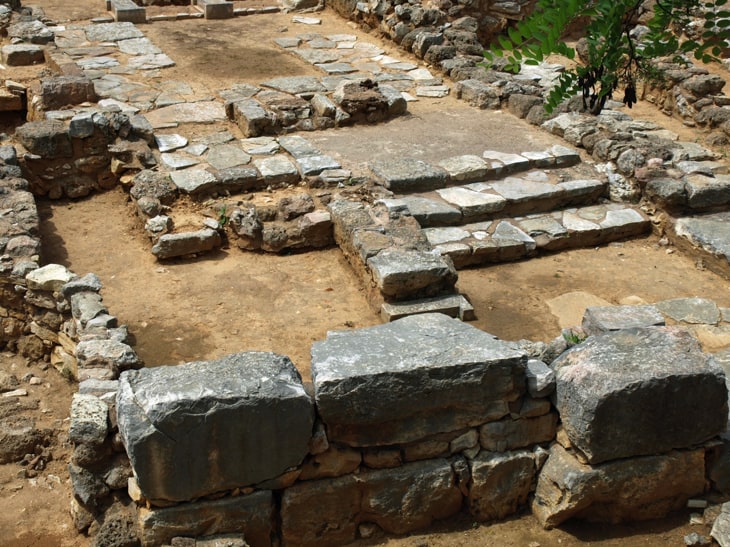
A few smaller sites have been unearthed, however, with the most significant being on the Kastelli hill, which is located behind the former Turkish mosque on the waterfront. Inhabiting the hill dates back to the earliest days of the Minoan civilization and continues all the way until the end of the Late Minoan IIIC period and beyond. Archaeologists have uncovered high-caliber buildings from the prepalatial era, particularly from the Early Middle Kingdom (EM) II and Early Middle Kingdom (EM) III-Middle Middle Kingdom (MM) IA. Despite the fact that the neopalatial town was built on top of the protopalatial levels, archaeologists were able to determine that there was a Middle Minoan community at Kydonia thanks to the discovery of Kamares pottery, eggshell ware, and stones with mason’s markings.
The Palace of Kydonia was added to the tentative list of UNESCO World Heritage Sites in January 2014. It was recognised as an outstanding example of a Minoan palace complex from the Bronze Era and is regarded as one of the most significant archaeological sites in Greece. Located on the island of Crete, the Palace of Knossos was the heart of the Minoan civilisation from around 1900 to 1300 BCE.
Some of the top must-see attractions at the Palace of Kydonia are the mosaic floors. The Palace of Kydonia is home to a large mosaic floor that was discovered during the excavation of the site. The mosaic features intricate geometric designs and is thought to have been part of a large ceremonial room. The Throne Room was the most important room in the palace and is believed to have been the location where the king received guests and conducted official business. Visitors are able to see the remains of the room’s walls and columns. Visitors must see the palace walls. They are a series of walls surrounding the Kydonia palace, and they serve as protection. The Old Venetian harbour, the archaeological museum of Chania, and the Chania Old town are among the must-see attractions in the Kydonia palace.
The best activities people do when visiting the Kydonia palace are strolling around the Old Venetian harbour, exploring the beauty of the palace, attending cultural events, and exploring the Chania old town. There are many great places to dine and buy in the Chania Old Town, which is characterised by its winding lanes and buildings from the Venetian era. Travellers are able to go sight-seeing and take in the local culture in the historically significant neighbourhood.
6. Gorge of Samaria National Park
The Gorge of Samaria is a national park located in the White Mountains of western Crete, Greece. It is a 16-kilometre-long gorge that runs from the Omalos plateau to the Libyan Sea, and it is considered one of the longest gorges in Europe. The gorge is home to a number of unique plant and animal species, so in 1962, the federal government designated the area around it as a national park to preserve them. The park welcomes hundreds of hikers and tourists from May through October.
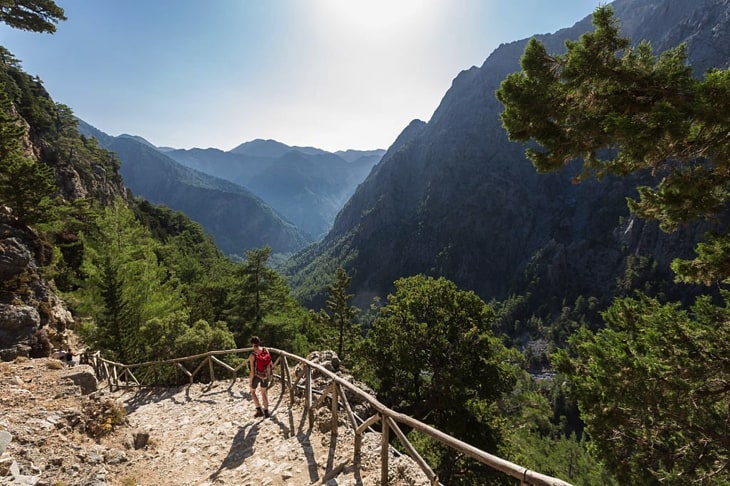
The Gorge of Samaria is a place of incredible beauty, with its sheer cliffs, gushing streams, and towering rock formations. The Cretan wild goat and the kri-kri, a subspecies of the wild goat, both of which are native to Crete, call the area home. The park’s topography is very difficult for hikers, with many steep inclines and rocks. Visitors need a ticket to enter the area, and the walk is likely to take anywhere from five to seven hours to complete.
The Gorge of Samaria has been protected by UNESCO as a Biosphere Reserve since 1981 because of the exceptional cultural and ecological significance it represents. However, the UNESCO World Heritage Committee has not included it on its list. The Gorge of Samaria, which is found in the White Mountains in western Crete, has a lengthy and eventful history to go along with its beautiful location. The gorge was created as a river carved its way through the limestone mountains over the course of millions of years, leaving behind dramatic landscape features such as steep cliffs, deep gorges, and stunning natural beauty.
There are a variety of archaeological monuments in the vicinity, including the ruins of the ancient city of Tarra, which was obliterated by an earthquake in the fourth century AD. These ruins are situated in the region around the gorge, which has been inhabited since ancient times. The rebels from Crete utilised the gorge itself as a natural defence during the Greek War of Independence in the early 19th century.
Mountaineers and hikers around the beginning of the 20th century were drawn to the region because of its difficult terrain and stunning natural beauty. The area became very popular as a result. The first organised hiking tours of the gorge were established in the 1960s, and in 1962, the region was proclaimed a national park in order to preserve the exceptional flora and fauna that are found in the area.
The Gorge of Samaria is a stunning natural wonder and national park in western Crete, Greece. One of the top must-see attractions at the Gorge of Samaria is, of course, the gorge itself. The gorge itself is the biggest attraction, a breathtaking natural wonder with sheer cliffs, gushing streams, and towering rock formations. Among the many things to do in the park, hiking through the gorge is a favourite. Another famous attraction is the iron gates. The Iron Gates are a narrow section of the gorge that is just 4 metres wide and has towering rock walls on either side. It is one of the most dramatic and awe-inspiring sections of the gorge.
The village of Samaria is another must-see attraction in the gorge. It was once a thriving community but was abandoned in the 1960s when the national park was established. Children get to enjoy the sights of kri-kri in the gorge. They are among the must-see attractions when visiting the Samaria gorge. The kri-kri is a species of wild goat that is endemic to Crete and is occasionally found only on the island. The park is home to a sizable population of these Cretan goats. Hikers that wander around the park are likely to catch sight of the kri-kri at some point. The park is home to a number of rare and endemic species of plants and animals, such as the Crete wild goat and the Cretan wildcat, in addition to a number of rare kinds of orchids and wildflowers. These animals and plants are found nowhere else on the planet. There are even natural pools and waterfalls in the Samaria Gorge, including the Neraidogourouna waterfall, which is a popular spot for swimming and cooling off during the hot summer months.
The Gorge of Samaria National Park, which is located in Crete, Greece, provides visitors of all ages and interests with a wide variety of activities to choose from. Hiking is a popular activity in Samaria gorge. It is a great way to explore the stunning natural beauty of the area. The hike takes approximately 5-7 hours to complete, and it is a challenging but rewarding experience. The park is home to a number of endangered and endemic plant and animal species, including the kri-kri, a species of wild goat that is unique to the island of Crete. The national park is ideal for wildlife spotting. Those that go through the park are likely to get a glimpse of the kri-kri and various other species of wildlife. People who love taking pictures and are into photography have plenty of opportunities to capture the stunning natural scenery and interesting wildlife.
7. Fortress of Spinalonga
The historical Fortification of Spinalonga is situated on a small island off the coast of Crete, Greece. It was constructed by the Venetians in the early 16th century to safeguard the eastern portion of Crete from Ottoman incursions. The fortress is situated on a rocky peninsula that juts into the water, affording it a favourable defensive posture. The fortification is surrounded by walls and bastions that are mostly intact at present. The walls are constructed of stone and strengthened by huge towers and gun positions. The entrance to the fortress is a massive gate that leads to an inner courtyard that was originally utilised for parades and public assemblies.
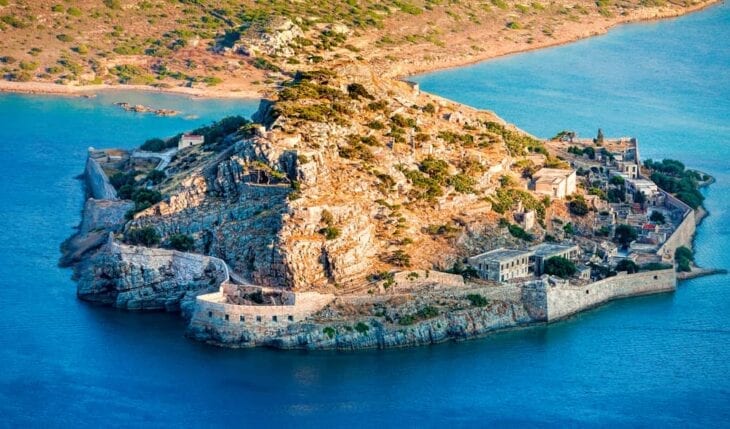
The castle was planned to be self-sufficient and had several structures for housing soldiers, food and supply storage facilities, and even a church. The structures were organised around a central courtyard that was used for military training and other purposes. The stronghold contains a number of Ottoman structures in addition to Venetian structures, including a mosque and many homes constructed during the 17th-century Ottoman control of the island.
The stronghold played an essential part in the defence of Crete, and it served as a haven for Christians fleeing Ottoman authority during the Venetian era. The island served as a leper colony until 1957, when it was abandoned later in the 20th century. The Fortress of Spinalonga is a renowned tourist destination that is accessible by boat from the nearby city of Elounda. Visitors are able to take in breathtaking views of the surrounding sea and coastline, in addition to exploring the fortress and its numerous historical landmarks.
The island and fortress of Spinalonga off the coast of Crete, Greece have a rich and eventful history. Since ancient times, people have lived on the island, and it has been the location of numerous towns and fortresses. The Venetians constructed the castle on Spinalonga to protect the island of Crete against Ottoman invasion during the early 1600s. The fortress’s location on a rocky peninsula that protruded into the sea was both advantageous and fortuitous. Buildings to house soldiers and store supplies were included in the fortress’s high walls, bastions, and towers. The castle was crucial to the defence of Crete during the Venetian era, and it was a safe haven for Christians fleeing Ottoman authority. When they occupied it in the 17th century, the Ottoman Turks constructed a mosque and a number of other buildings. The island served a number of functions as time passed following the Ottoman era, including as a leper colony and a quarantine facility for those afflicted by the plague. The leper colony first opened its doors in 1903 and continued to treat patients until 1957, when the final patient was sent to a mainland hospital.
The Fortress of Spinalonga is not yet included on the list of World Heritage Sites maintained by UNESCO as of the moment. On the other hand, it is one of the potential locations in Greece that could be included on the World Heritage List in the near future. The provisional list has not been updated since 2019, and it now consists of a variety of significant cultural and natural sites located all around Greece. These locations are currently being evaluated by both the Greek government and UNESCO to determine whether or not they should be included on the World Heritage List. If the Fortress of Spinalonga were to be included on the World Heritage List, it would join a number of other significant cultural and historical monuments in Greece, such as the Acropolis in Athens, the ancient site of Delphi, and the monasteries of Meteora. These are just a few examples.
Spinalonga Fortress, located on the Greek island of Crete, is one of the island’s most famous landmarks. Firstly, the fortress’s Venetian walls and bastions are impressive, and the various turrets and gun emplacements that are still mostly intact today are a delight to explore. Second, the fortress’s Ottoman mosque and residences are significant cultural artefacts because they shed light on the island’s rich past. Finally, the leper colony’s ruins from the early twentieth century are a sobering reminder of the island’s more recent past. Visitors get to look around the former hospital and observe where the lepers used to live while they were isolated on the island. Last but not least, the island’s elevated position provides breathtaking panoramas of the sea and coastline that are sure to leave an indelible mark on visitors and provide a fresh viewpoint of Crete’s pristine landscape.
The Spinalonga Fortress offers various activities to its visitors. One famous activity enjoyed by visitors are the boat trips. Visitors have the chance to take a boat trip around the island, offering a unique perspective on the fortress and its surroundings. Snorkelling and scuba diving are two popular activities around the island. The crystal-clear waters around the island are perfect for snorkelling and scuba diving, with plenty of marine life and underwater attractions to discover. Taking it easy on the island’s stunning beaches is another great activity in the Spinalonga castle. The island is home to a number of breathtaking beaches that are excellent for swimming, sunbathing, and taking it easy.
Which is the most engaging and family-friendly UNESCO site for kids in Crete?
The Palace of Knossos is the most engaging and family friendly UNESCO site for kids in Crete. The palace offers a range of interactive exhibits and activities that allow kids to learn about the history of the Minoan civilization in a fun and engaging way. These include games, puzzles, and interactive displays that help bring the history of the palace to life. The palace’s architecture is unique and fascinating, with intricate frescoes, colourful mosaics, and intricate stonework that is sure to capture the imagination of children. The palace is surrounded by beautiful gardens and outdoor spaces that are perfect for kids to run around and explore. There are shaded areas as well where families get to relax and enjoy a picnic. The Minoan civilization had a rich mythology, and many of its myths and legends are still familiar today, such as the story of the Minotaur. Kids are able to learn about these myths and legends while exploring the palace, which makes the experience more interesting and engaging.
What is UNESCO?
The United Nations Educational, Scientific, and Cultural Organization (UNESCO) was established in 1945 as a specialised agency of the United Nations. Its goal is to strengthen international partnerships in the fields of learning, research, and communication in order to foster global stability and support long-term progress.
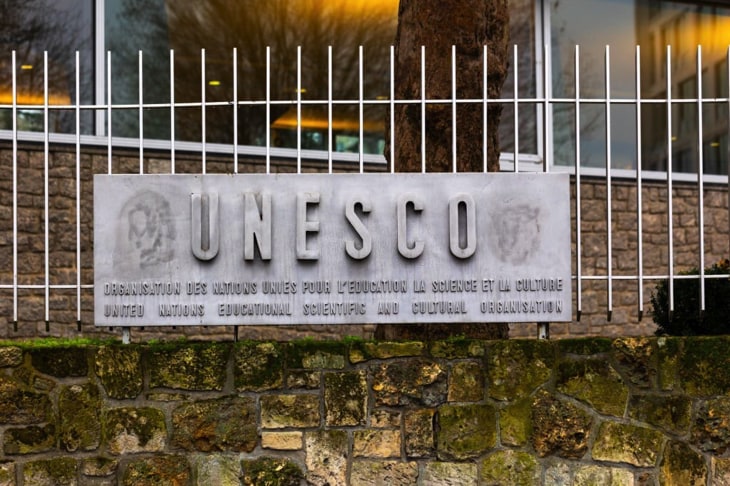
UNESCO’s efforts to protect cultural landmarks, promote literacy and education, and fund scientific research have all been critical in bringing the world closer together and increasing its capacity for mutual understanding and collaboration. Its ultimate goal is to help bring about a future in which everyone has access to high-quality education, cultural differences are respected, and scientific advancements are shared for the good of all. The United Nations Educational, Scientific, and Cultural Organization (UNESCO) is an international organisation with a mission to increase international cooperation in the areas of education, science, and culture for the benefit of sustainable development and world peace. The work it does is crucial in today’s interconnected world, when international cooperation and collaboration are needed to address global concerns like climate change, poverty, and violence.
Why were the sites in Crete chosen as UNESCO World Heritage Sites?
The UNESCO World Heritage Sites in Crete were selected because of their unparalleled worth to all people everywhere as well as their significance to the history and culture of humans. Each location illustrates a distinctive facet of the island’s extensive cultural past and adds to the comprehension of the evolution of human civilisation. For instance, the Minoan Palace of Knossos is considered to be one of the most significant archaeological sites in the Mediterranean. Its palace offers significant insights into the intricate society and culture of the Minoans, who were one of the oldest civilizations in Europe. Similarly, the Spinalonga Fortress are both a testament to the strategic importance of Crete during the mediaeval and early modern periods and a demonstration of the influence that Venetian military architecture had in the Mediterranean region.
What can visitors expect to see at the UNESCO World Heritage Sites in Crete?
Visitors touring the UNESCO World Heritage Sites in Crete are able to anticipate seeing a diverse range of spectacular archaeological and cultural heritage sites. These sites provide visitors with significant insights into the history of the Minoan civilization as well as its accomplishments. Each location features one-of-a-kind amenities and attractions, such as impressive frescoes and other forms of ornate decoration, well-preserved ruins of palaces, temples, and other significant buildings, and a wealth of artefacts and exhibits relating to the daily life, art, and architecture of the Minoans. Each location is located on the island of Crete in Greece. Visitors have the option of exploring the numerous locations at their own pace or participating in guided tours, during which they gain additional knowledge regarding the background and significance of each location. Moreover, they have the opportunity to take part in educational exhibitions and interactive experiences that furthers their comprehension of the Minoan civilisation and the significant contributions it made to human history and culture. Generally, tourists who visit the UNESCO World Heritage Sites on the island of Crete are likely to anticipate having a one-of-a-kind and enlightening cultural and historical experience that remains with them for the rest of their lives.
How are the UNESCO World Heritage Sites in Crete protected and preserved?
The Greek government and local authorities work closely with international organisations such as UNESCO and ICOMOS (the International Council on Monuments and Sites) to ensure that the World Heritage Sites in Crete are protected and preserved in a responsible and sustainable manner. One specific law that protects the UNESCO World Heritage sites is Law 3028/2002. The law regulates the protection of archaeological sites and monuments in Greece, including those that are part of the World Heritage Sites in Crete. It says how these sites must be protected, kept in good shape, and managed. It says what is going to happen if people don’t follow the rules. The Greek Constitution recognizes the value of protecting the country’s cultural heritage, including its World Heritage Sites. Article 24 of the Constitution states that the state has an obligation to protect and promote the country’s cultural heritage. Greece has signed on to a number of international agreements that help protect and keep World Heritage Sites in good shape. These include the 1954 Convention for the Protection of Cultural Property in the Event of Armed Conflict, the 1972 World Heritage Convention, and the 2003 Convention for the Safeguarding of Intangible Cultural Heritage.
Are there admission fees for the UNESCO World Heritage Sites in Crete?
Yes, most of Crete’s UNESCO World Heritage Sites do charge an entrance fee. Admission prices vary by location, with some offering discounts for students, pensioners, and organised groups. The Minoan Palace of Knossos, for instance, charges €15 for adults to enter in 2021, while allowing free entry to those under the age of 18 and all students from the European Union. Equally, the Archaeological Site of Phaistos charges €8 for people, with reductions for students, elderly, and groups. Greece is a signatory to the World Heritage Convention, which establishes the legal framework for the protection and preservation of World Heritage Sites around the world.
Keep in mind that entrance costs are subject to change. It’s best to double-check the site’s official website or get in touch with the venue in question to learn about the most up-to-date rates and any applicable discounts. While the cost of admission to some of Crete’s UNESCO World Heritage Sites is a factor in someone’s decision to visit, one must know that these costs are usually fairly reasonable and amount to a tiny price to pay for the opportunity to discover these important cultural and historical places.
Are there guided tours available at the UNESCO World Heritage Sites in Crete?
Yes, there are guided tours available at many of the UNESCO World Heritage Sites in Crete. These tours are a great way to learn more about the history and significance of these important cultural and historical sites, and to gain a deeper understanding of the local culture and traditions. Many of the sites, such as the Minoan Palace of Knossos and the Archaeological Site of Phaistos, offer guided tours on site, which are booked in advance or arranged upon arrival. These tours are typically led by knowledgeable local guides who are able to provide insight and context to the site and its history. Additionally, there are many tour companies and travel agencies that offer organised tours to the UNESCO World Heritage Sites in Crete. These tours include transportation, entrance fees, and guided tours, and a great way to explore multiple sites in a single day.
What is the best time to visit the UNESCO World Heritage Sites in Crete?
The ideal time to visit the UNESCO World Heritage Sites in Crete is during the months of May and June. The summer months are the best time to visit for people who enjoy outdoor activities like hiking and swimming. Crete is a well known tourist destination, and the World Heritage Sites tend to get crowded during the peak season (June to August). Tourists who want to avoid crowds must go during the shoulder seasons or even off-season (November to March). Shoulder seasons and off-seasons are ideal times to visit a destination since they have more manageable temperatures and fewer tourists.
Do I need a car to visit the UNESCO World Heritage Sites in Crete?
Yes, anyone who plans to visit the UNESCO World Heritage Sites in Crete must use a vehicle for convenience. Some of the more remote UNESCO sites, such as the Palace of Zakros, are more difficult to access without a car. In these cases, it is worthwhile to rent a car or join a guided tour to ensure that one is able to visit these important cultural and historical sites. Hiring a car on the island of Crete is a practical method to see the sights. Renting a car gives vacationers independence and the freedom to explore the island as they like. Travelling between Crete’s major attractions is a breeze because of the island’s well-developed road network. In addition, travellers can easily rent a car upon arrival as there are numerous automobile rental firms located in the country’s major towns and airports. Tourists are able to travel at their own leisure and escape the stress of figuring out public transportation by renting a car. The island’s beautiful beaches, quaint villages, and important historical sites are all within easy driving distance for guests with their own vehicle.
What type of car should I rent for visiting the UNESCO World Heritage Sites in Crete?
Visiting the UNESCO World Heritage Sites in Crete requires an ideal car depending on a few factors, including one’s personal preferences, the size of the group, and the particular sites one is planning to visit. A compact or midsize car like the Volkswagen Polo is sufficient, as the parking areas are relatively small and the roads leading to the sites are generally easy to navigate when visiting the Palace of Knossos, Archaeological Site of Phaistos, and Fortress of Spinalonga. A larger car or SUV like the Nissan Xtrail is likely to be more suitable, as the road leading to the gorge is steep and winding, and there is rough terrain along the way. These types of cars are generally suitable for exploring the more rugged terrain in Crete, such as the mountainous areas or the Samaria Gorge. They offer more space and comfort for larger groups or families. However, keep in mind that they are likely to be less fuel efficient and more difficult to navigate in narrow city streets or small parking areas.
Where can I rent a car in Crete?
There are several car rental companies in Crete where people have plenty of options to rent a car, including international brands and local businesses. Some of the most famous options include Rental Center Crete, which has several locations throughout Crete, including at the airports and in major cities like Heraklion and Chania. The have has several locations in Crete, including at the airports and in major tourist areas like Rethymno and Agios Nikolaos. Car rental Crete is a popular and convenient option for navigating around the island, as it allows travellers to explore the island at their own pace and on their own schedule.
What documents do I need to rent a car in Crete?
Listed below are some documents needed to rent a car in Crete:
- A valid driver’s licence: Customers must have a valid driver’s license from their home country or an International Driving Permit (IDP) in order to rent a car in Crete. Their licence must be in English or Greek, or they need to provide an official translation.
- A valid passport or ID card: Customers need to provide a valid passport or ID card as proof of identity when renting a car in Crete.
- A credit or debit card: Customers need to have a debit or credit card in their name to cover the rental fees and any potential damages or fines. Debit cards are generally accepted.
- Rental agreement: Customers need to sign a rental agreement that outlines the terms and conditions of the rental, including the rental period, insurance coverage, and any additional fees.
Are there any special driving laws or regulations in Crete that I should be aware of?
Yes, there are some special driving laws and regulations in Crete that one must be aware of if they plan to drive on the beautiful island. For example, the use of seat belts is mandatory for both the driver and all passengers in the car, and failure to comply results in fines. Additionally, the legal blood alcohol limit is lower than in many other countries, at 0.05%, and the police conduct regular sobriety checks. It is important to note that some of the roads in Crete are narrow and winding, and there are often steep drops and sharp turns. It is recommended that drivers exercise caution and avoid excessive speed, especially when driving on unfamiliar roads. The right side of the road is the preferred lane for drivers on the island of Crete (opposite to the UK, the same as the United States and most of Europe). Vehicles approaching a roundabout from the right have the right of way unless otherwise indicated by a sign. All other vehicles must yield to those entering a roundabout. Keep left to pass on the motorway. As a general rule, slower vehicles should move to the hard shoulder to allow faster vehicles to pass. Lastly, parking restrictions are strictly enforced in some areas, particularly in the larger cities, so it is important to pay attention to signage and parking regulations to avoid fines or having their vehicle towed.
Last updated on February 11th, 2025














